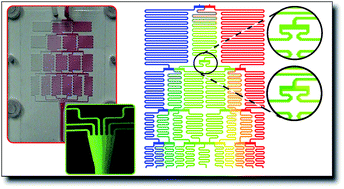Optimisation and analysis of microreactor designs for microfluidic gradient generation using a purpose built optical detection system for entire chip imaging
Abstract
This paper presents and fully characterises a novel simplification approach for the development of microsystem based concentration gradient generators with significantly reduced microfluidic networks. Three microreactors are presented; a pair of two-inlet six-outlet (2–6) networks and a two-inlet eleven-outlet (2–11) network design. The mathematical approach has been validated experimentally using a purpose built optical detection system. The experimental results are shown to be in very good agreement with the theoretical predictions from the model. The developed networks are proven to deliver precise linear concentration gradients (R2 = 0.9973 and 0.9991 for the (2–6) designs) and the simplified networks are shown to provide enhanced performance over conventional designs, overcoming some of the practical issues associated with traditional networks. The optical measurements were precise enough to validate the linearity in each level of the conventional (2–6) networks (R2 ranged from 0.9999 to 0.9973) compared to R2 = 1 for the theoretical model. CFD results show that there is an effective upper limit on the operating flow rate. The new simplified (2–11) design was able to maintain a linear outlet profile up to 0.8 µl/s per inlet (R2 = 0.9992). The proposed approach is widely applicable for the production of linear and arbitrary concentration profiles, with the potential for high throughput applications that span a wide range of chemical and biological studies.


 Please wait while we load your content...
Please wait while we load your content...